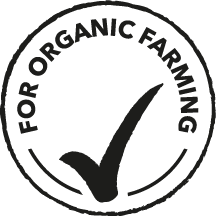
Grain Legumes
The cultivation of grain legumes has been popular for several years. Not least, this development has been triggered by agronomic and climatic changes as well as political measures. Agricultural production methods focused on sustainability now have domestic protein crops in their sights, and with them the rising demand for regionally produced food and feed.
Legumes – versatile and valuable for healthy farming
Grain legumes have excellent pre-crop effects. They improve soil structure, have a phytosanitary effect and, in symbiosis with nodule bacteria, supply themselves with nitrogen from the air. The balanced supply of other necessary nutrients, however, is essential.
- Protein and energy from the cultivation of native protein plants.
- Potassium causes the increased formation of nodule bacteria and is therefore the basis for high yields.
- Magnesium promotes protein formation and quality.
- Sulfur improves nitrogen utilization and is indispensable for protein synthesis.
Protein and energy as a feed supplement
Soybeans, field beans, peas, and lupins belong to the large-grain legume species. They are particularly rich in protein and have a high energy value. The domestic grain legumes are mainly used as supplementary feed to soybean meal.
Sustainably high yields can only be achieved with an optimal production process. This includes a targeted supply of nutrients. Grain legumes are capable of fixing nitrogen from the air via nodule bacteria. The prerequisite for effective utilization of this N fixation is, among other things, optimum supply of potassium, magnesium and sulfur.
Grain legumes...
- bind atmospheric nitrogen using nodule bacteria, which is available as a sustainable N source for the following crop via the enteric residues
- have deep tap roots in some cases - this improves the soil structure (field bean, lupin) on the one hand and enables nutrient uptake from deeper soil layers on the other
- promote soil fertility, as they leave behind a good soil coarseness and crumb structure, and the build-up of stable humus forms is promoted
- have a positive impact on water storage capacity and biological activity of the soil
- increase the diversity of the crop rotation
- interrupt the infection chain of soil-borne pathogens
The most important nutrients for grain legumes
Potassium – is the basis of high yields

- Potassium is of great importance for N2 fixation by nodule bacteria and therefore for seed and protein yield.
- The effect is due to both increased formation of nodules and increased bacterial activity.
- A good supply of potassium promotes the formation of proteins from amino acids, as potassium activates important enzymes for this purpose.
- Grain legumes absorb almost the entire potassium requirement of 220-270kg/ha K2O within 6 weeks (shortly before flowering to end of flowering).
- Including the already dead leaves, the plants absorb about 170-200kg/ha K2O until maturity, of which about 40% is contained in the grains.
Magnesium and sulfur – for high protein content and quality

As protein-rich plants, grain legumes have high requirements for magnesium and sulfur.
- A good supply of magnesium to the crop guarantees continued assimilation of the leaves until harvest and therefore ensures optimized storage of the carbohydrates in the grains, promoting yield.
- Magnesium activates a large number of enzyme systems in protein metabolism, thus influencing protein content and quality.
- A good supply of sulfur leads to efficient use of fixed or absorbed nitrogen, promotig overall biomass production and yield.
- Sulfur is indispensable for the formation of sulfur-containing amino acids and consequently for the entire protein synthesis.
Fertilizer recommendations for grain legumes
Recommendation for soil fertilization
The following fertilization recommendations are calculated on the nutrient removal of the main crop product on the basis of optimum soil nutrient contents (in Germany, soil content class "C"). Surcharges for soil-specific losses due to leaching, fixation, or erosion are not taken into account.
|
PatentKALI® ESTA® Kieserit GRAN./p> Korn-KALI® |
|
Product recommendation



Recommendation for foliar fertilization
Foliar fertilization effectively supplies the plant with the micronutrients boron, manganese, zinc, or copper.
It also supplements soil fertilization with rapidly available macronutrients such as magnesium and sulfur. During periods of strong growth, foliar fertilization secures the supply of peak demands and reliably ensures an optimum supply of nutrients even in dry conditions or when sulfur mineralization is too slow.
This ensures the best yields and qualities. If deficiency symptoms have already occurred, foliar fertilization provides an effective and quickest possible remedy.
Product Recommendations
A total of 20-25kg/ha epsoMICROTOP in a 5% concentration, for meeting peak demands, i.e. for rectifying latent deficiencies of magnesium, sulfur and trace minerals. Product may be applied in several split applications.
